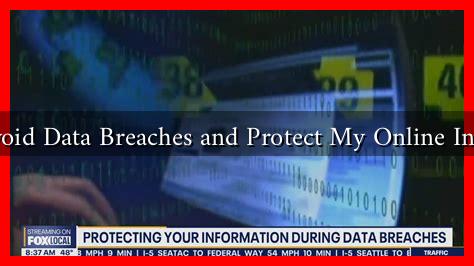-
Table of Contents
- How to Avoid Data Breaches and Protect My Online Information
- Understanding Data Breaches
- Best Practices for Protecting Your Online Information
- 1. Use Strong, Unique Passwords
- 2. Enable Two-Factor Authentication (2FA)
- 3. Regularly Update Software and Devices
- 4. Be Wary of Phishing Scams
- 5. Secure Your Wi-Fi Network
- Monitoring and Responding to Data Breaches
- Conclusion
How to Avoid Data Breaches and Protect My Online Information
In an increasingly digital world, the importance of safeguarding personal information cannot be overstated. Data breaches have become alarmingly common, with millions of records compromised each year. According to a report by IBM, the average cost of a data breach in 2023 was approximately $4.45 million. This article will explore effective strategies to avoid data breaches and protect your online information.
Understanding Data Breaches
Before diving into prevention strategies, it’s essential to understand what a data breach is. A data breach occurs when unauthorized individuals gain access to sensitive data, such as personal identification information, financial records, or login credentials. These breaches can happen due to various reasons, including:
- Malware attacks
- Phishing scams
- Weak passwords
- Inadequate security measures
High-profile cases, such as the Equifax breach in 2017, which exposed the personal information of 147 million people, highlight the severe consequences of data breaches. Understanding these risks is the first step in protecting your information.
Best Practices for Protecting Your Online Information
To minimize the risk of data breaches, consider implementing the following best practices:
1. Use Strong, Unique Passwords
One of the simplest yet most effective ways to protect your online accounts is by using strong, unique passwords. A strong password should include:
- At least 12 characters
- A mix of uppercase and lowercase letters
- Numbers
- Special characters (e.g., !, @, #, $)
Additionally, avoid using the same password across multiple sites. Password managers like LastPass or 1Password can help you generate and store complex passwords securely.
2. Enable Two-Factor Authentication (2FA)
Two-factor authentication adds an extra layer of security by requiring a second form of verification in addition to your password. This could be a text message code, an email confirmation, or a biometric scan. According to Google, 2FA can block up to 100% of automated bots and 96% of phishing attacks.
3. Regularly Update Software and Devices
Keeping your software and devices updated is crucial for security. Software updates often include patches for vulnerabilities that hackers can exploit. Set your devices to update automatically whenever possible, and regularly check for updates on applications and operating systems.
4. Be Wary of Phishing Scams
Phishing scams are one of the most common methods used by cybercriminals to gain access to sensitive information. Be cautious of unsolicited emails or messages that ask for personal information or direct you to unfamiliar websites. Always verify the sender’s identity before clicking on links or downloading attachments.
5. Secure Your Wi-Fi Network
Your home Wi-Fi network can be a gateway for cybercriminals if not properly secured. To protect your network:
- Change the default router password
- Use WPA3 encryption
- Disable remote management features
- Regularly check connected devices
Monitoring and Responding to Data Breaches
Even with the best preventive measures, data breaches can still occur. Here are steps to take if you suspect a breach:
- Change your passwords immediately.
- Monitor your financial accounts for unauthorized transactions.
- Consider enrolling in identity theft protection services.
- Report the breach to relevant authorities.
Conclusion
In conclusion, protecting your online information from data breaches requires a proactive approach. By using strong passwords, enabling two-factor authentication, keeping software updated, being cautious of phishing scams, and securing your Wi-Fi network, you can significantly reduce your risk. Remember, the digital landscape is constantly evolving, and staying informed about the latest security practices is essential. For more information on cybersecurity, you can visit the Cybersecurity & Infrastructure Security Agency (CISA).
By implementing these strategies, you can safeguard your personal information and enjoy a more secure online experience.

